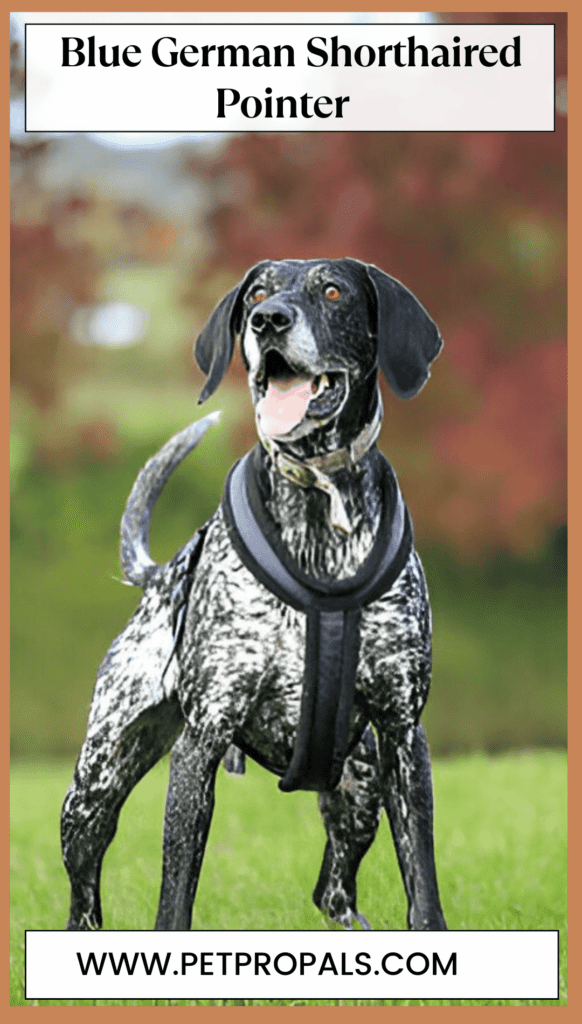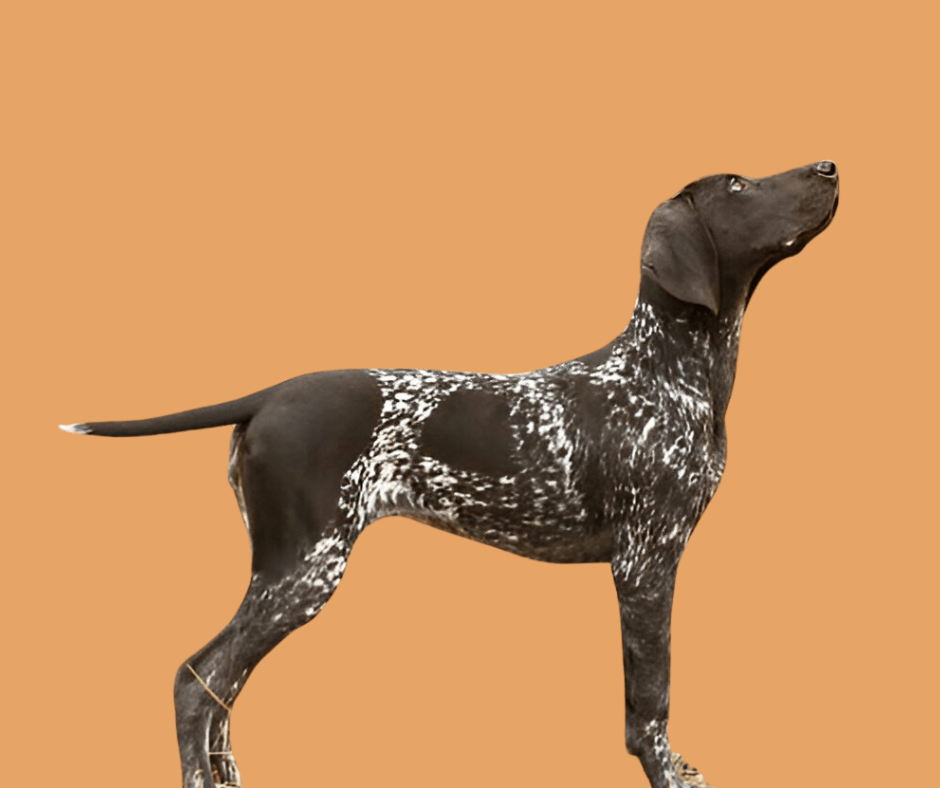Think all German Shorthaired Pointers are the same? Think again. The Blue German Shorthaired Pointer (Blue GSP) is a rare and stunning variation of this popular breed, known not just for its eye catching coat but also for its intelligence, athleticism, and affectionate personality.
Unlike the traditional liver or black GSPs, the Blue GSP features a unique steel gray or bluish coat that sets it apart in both looks and charm. But there’s more to this dog than its beautiful appearance.
As one of the top 10 most popular breeds in the U.S., according to the American Kennel Club (AKC), German Shorthaired Pointers are loved for their versatility and loyalty, and the Blue GSP is no exception. This article will walk you through everything you need to know about this special version of the breed.
From their history and physical traits to training tips, care requirements, and whether they fit your lifestyle, this guide will help you decide if the Blue German Shorthaired Pointer is the perfect dog for you.
History and Origins Of the Blue German Shorthaired Pointer

The German Shorthaired Pointer (GSP) originated in 19th-century Germany, where breeders set out to create the ultimate all-purpose hunting dog. Their goal? A versatile canine that could track, point, and retrieve game across all types of terrain, whether on land or in water.
To achieve this, early breeders crossed the Spanish Pointer with native German scent hounds. Later, they introduced English Pointers to improve speed and agility. The result was a smart, agile, and hard-working dog that quickly gained a reputation as both a capable hunting partner and a loyal family companion.
Thanks to its incredible adaptability, the German Shorthaired Pointer became one of the most popular sporting breeds worldwide and ranks consistently in the AKC’s top 10 breeds in the U.S.
Purpose and Characteristics
The GSP wasn’t just bred for looks, it was built to work. With a powerful nose and an innate drive to hunt, this breed excels at pointing and retrieving a variety of game. It’s just as comfortable flushing out birds in open fields as it is diving into lakes to fetch waterfowl.
These dogs are known for their:
- Exceptional stamina for long hunts
- High intelligence and quick learning ability
- Trainable and eager-to-please personality
- Friendly temperament that suits active families
Whether you’re looking for a field companion or a high-energy pet, the GSP checks both boxes.
The Unique Appearance of the Blue GSP
Now, let’s talk about the Blue German Shorthaired Pointer a head-turning variation of the breed that’s not officially recognized by the AKC but adored by fans for its rare and beautiful coat.
Standard Coat Colors in GSPs
Most GSPs come in two main coat variations:
- Liver Roan: The most common, this mix of brown and white hairs creates a freckled or speckled appearance.
- Black Roan: Less common but still recognized, black roan features black and white hairs with a similar speckling effect.
The Blue Variation
The Blue GSP sports a unique steel-gray or bluish coat. This rare color results from a genetic dilution of the black pigment, creating a soft, smoky-blue appearance. While not accepted for show under AKC standards, this color is growing in popularity among pet owners and hunters who admire its distinct look.
Size and Build of the Blue GSP
The Blue GSP shares the same physical build as standard German Shorthaired Pointers: a lean, athletic frame built for endurance and agility.
- Male Blue GSPs: 23–25 inches tall, weighing 55–70 lbs
- Female Blue GSPs: 21–23 inches tall, weighing 45–60 lbs
These dogs are the perfect blend of grace and muscle, making them agile runners, powerful swimmers, and tireless workers.
Eyes That Speak Volumes
One of the most captivating features of the Blue German Shorthaired Pointer is its expressive eyes. Medium-sized and set wide apart, the eyes give off an intelligent, alert, and often soulful expression.
- Eye Colors: Typically brown or hazel
- Expression: Friendly, aware, and full of curiosity
These eyes are not just beautiful, they reflect the breed’s sharp mind and social nature.
Temperament and Energy: What to Expect from a Blue GSP

The Blue German Shorthaired Pointer (GSP) is more than just a pretty face, it’s a high-energy, playful, and intelligent breed that thrives in active homes. Known for their enthusiasm and zest for life, these dogs demand both physical activity and mental stimulation daily.
If you’re considering this breed, it’s essential to know that the Blue GSP is happiest when busy and can quickly become restless if under-stimulated.
Daily Exercise Requirements
This isn’t a dog that’s content lounging around all day. The Blue GSP needs serious exercise,t hink long walks, runs, hikes, or off-leash play in a secure area. These dogs were bred to hunt, and their bodies are built for stamina, agility, and endurance.
Here’s what your Blue GSP might enjoy:
- Running or jogging with you
- Swimming in lakes, ponds, or pools
- Dog sports like agility, flyball, or dock diving
- Interactive games like fetch or frisbee
But physical exercise alone isn’t enough. These clever pups also crave mental workouts. Training games, obedience drills, scent work, and puzzle toys all help keep their minds engaged and prevent unwanted behavior. Why Low-Activity Owners Might Struggle
While the Blue GSP is a dream dog for active people, it can be overwhelming for less active households. Their energy needs are high, and if not met, your dog may turn to destructive behaviors such as:
- Excessive barking
- Chewing furniture or objects
- Digging holes in the yard
- Restlessness and anxiety
These aren’t signs of a “bad dog,” they’re signs of boredom and frustration. If you’re not up for daily activity and mental stimulation, a different breed may be a better fit.
A Loyal and Loving Family Member
Despite their working-dog heritage, Blue GSPs are incredibly affectionate and people-oriented. They form deep bonds with their families and love being part of the action, whether it’s a hike in the woods or a lazy Sunday morning cuddle.
Family-Friendly Traits
- Gentle with children: Their playful, patient demeanor makes them great with kids, just supervise playtime with younger children due to the breed’s energy.
- Strong family loyalty: They naturally want to be close to their humans, often following you from room to room.
- Protective instincts: Though not aggressive, they can be watchful and alert, making them effective watchdogs.
If you’re looking for a dog that’s part athlete, part cuddlebug, the Blue GSP fits the bill.
Aloof with Strangers? Socialization Matters
While friendly and affectionate with their family, Blue GSPs can be a bit reserved or shy around strangers. This isn’t necessarily a flaw it’s just part of their personality. However, early socialization is crucial to help them feel confident and relaxed in various social settings.
Tips for Successful Socialization
- Expose them to different people: Encourage calm, positive experiences with guests, delivery workers, and passersby.
- Vary their environments: Bring your pup to parks, pet-friendly shops, and outdoor events.
- Use positive reinforcement: Reward calm and friendly behavior with treats or praise.
Gradual, consistent exposure to new situations helps your Blue GSP grow into a well-adjusted, sociable adult. And if your dog seems shy around strangers, don’t force interactions. Allow them to warm up at their own pace and always reinforce positive behaviors.
Price and Costs of Owning a Blue German Shorthaired Pointer
Thinking about bringing home a Blue German Shorthaired Pointer (GSP)? It’s important to consider not just the initial price but also the long-term costs of caring for this active and intelligent breed. From food and grooming to vet bills and training, expenses can add up quickly.
Let’s break down the typical costs associated with owning a Blue GSP, so you know what to expect.
Initial Purchase Price
Depending on the breeder’s reputation, pedigree, and location, a Blue GSP puppy can cost between $800 and USD 2,000. Dogs from top-quality breeders or with show or working bloodlines may come at the higher end of this range, or even more.
It’s worth noting that the rare blue coat color might come with a premium price tag, especially from breeders who specialize in this variation.
Monthly and Annual Expenses
Here’s a breakdown of common recurring costs:
| Cost Category | Estimated Cost |
|---|---|
| Food (monthly) | 40 – 60 USD |
| Veterinary Care (annual) | 100 – USD 300 initially, with ongoing costs |
| Grooming (per session) | 30 – USD 50 |
| Training & Supplies | 30 – USD 50 |
Food: Blue GSPs are medium-to-large dogs with high energy needs, which means they’ll need a high-quality diet to stay healthy and active. Expect to spend $40 to $60 each month on kibble or raw food, depending on the brand and feeding plan.
Vet Bills: Routine vet visits, vaccinations, flea and tick prevention, and occasional treatments can add up to $200–$400 per year. Unexpected issues or emergencies could raise this figure, so it’s wise to set aside extra for unplanned expenses.
Grooming: While GSPs have short, low-maintenance coats, they still benefit from regular grooming to keep their skin and fur healthy. Occasional professional grooming sessions may cost $30 to $50, depending on your location.
Training & Supplies: Training is crucial for this intelligent and energetic breed. Initial training, leashes, crates, toys, and basic gear might cost $100–$300. You’ll also need to replace toys and accessories as your dog grows or wears them out.
Hidden or Occasional Costs
Beyond daily care, consider these potential expenses:
- Pet insurance: $25–$70 per month, depending on coverage
- Boarding or pet sitting: $25–$50 per day if you travel
- Dog sports or activities: Entry fees or classes for agility, obedience, or scent work
- Licensing and microchipping: Small one-time or annual fees, depending on your area
Is a Blue GSP Worth the Investment?
Owning a Blue German Shorthaired Pointer can be incredibly rewarding, but it’s also a financial commitment. If you’re prepared for the upfront and ongoing expenses, you’ll be rewarded with a loyal, active, and affectionate companion who thrives in an engaged and active household.
Taking the time to plan and budget ahead of time helps ensure your Blue GSP lives a happy, healthy life ,and saves you from surprises down the road.
How to Care for a Blue German Shorthaired Pointer

Like every dog breed, the Blue German Shorthaired Pointer (GSP) needs proper care to stay healthy, happy, and well-behaved. From exercise to grooming and everything in between, here’s a complete care guide to help your Blue GSP thrive.
Exercise Needs: Keep That Energy in Check
The Blue GSP is full of energy, and they need at least 1 to 2 hours of exercise every day. This can include:
- Long walks or jogs
- Fetch sessions at the park
- Agility training or obstacle courses
- Hiking or swimming adventures
They were bred to be hunting dogs, so physical activity isn’t just beneficial ,it’s essential. Without enough movement, they may develop behavior issues like chewing, digging, or barking out of boredom.
Mental stimulation is just as important. Puzzle toys, scent games, and learning new tricks help keep their smart minds sharp and satisfied. Training: Smart, Willing, and Eager to Please
Training your Blue GSP doesn’t have to be difficult, but it does require consistency and patience. These dogs are:
- Intelligent and quick learners
- Responsive to positive reinforcement like treats, praise, and play
- Sensitive to harsh training methods (which should be avoided)
Start training early and focus on basic obedience, leash manners, and socialization with other pets and people. Puppy classes and continued training help shape a polite, confident dog you can take anywhere.
Grooming Needs: Low Maintenance but Not No Maintenance
The Blue GSP has a sleek, short coat that doesn’t require extensive grooming, but regular upkeep still matters.
Here’s what you’ll need to do:
- Brush once or twice a week to remove loose hairs and reduce shedding
- Bathe occasionally using a gentle dog shampoo
- Trim nails regularly to prevent discomfort or injuries
- Clean ears to avoid infections, especially after swimming
- Brush teeth a few times a week to support dental health
Even though grooming is easy, staying consistent helps keep their coat shiny and their skin healthy.
Health Tips: Prevention is Key
Like all dogs, Blue GSPs can be prone to certain health conditions, especially if not responsibly bred. Common concerns include:
- Hip dysplasia
- Bloat (gastric torsion)
- Eye conditions
- Allergies
To keep your dog in top shape:
- Schedule regular vet checkups
- Choose a breeder who screens for genetic conditions
- Feed a balanced diet with proper nutrients
- Maintain a safe, clean environment
- Ensure your GSP gets both mental and physical enrichment
Staying proactive about your dog’s health can add years to their life and keep their quality of life high.
Best Lifestyle: Is Your Home the Right Fit?
The Blue German Shorthaired Pointer isn’t a couch potato , they need an active lifestyle. They’re best suited for:
- Active families who enjoy outdoor adventures
- Homes with yards where the dog can run freely
- People are committed to regular training and play
If you live in an apartment, it’s still possible to own a Blue GSP ,but you’ll need to be extra diligent about their exercise and mental stimulation routine.
This breed thrives when they’re involved in family activities, whether it’s a hike in the woods or playing in the backyard.
Excelling in Dog Sports and Activities
Blue GSPs shine when given a job to do. They excel in dog sports like:
- Agility: Quick-footed and focused, they love running obstacle courses.
- Dock Diving: Their athletic build makes them perfect for leaping into water.
- Obedience Trials: Their intelligence makes them great at structured commands and routines.
- Hunting or Field Work: Their instincts are unmatched if you’re in a legal hunting area.
These activities don’t just keep your GSP fit, they also provide an outlet for their natural drive and mental focus.
Final Tip: A happy Blue GSP is one with a job, plenty of exercise, mental challenges, and lots of love. If you’re ready for the commitment, you’ll gain a loyal companion who’s always eager to be by your side.
How To Bring Home a Blue GSP?
When searching for a Blue GSP, look for a breeder who prioritizes health checks and temperament testing to raise well-adjusted dogs and support the breed’s overall health.
Consider adopting a rescue organization that specializes in GSPs. It’s a great way to give a deserving dog a second chance at a loving home, and it’s generally more cost-effective than buying from a breeder.
When choosing a Blue GSP puppy, consider their temperament, activity level, and potential health risks.
When looking for puppies, prioritize those who are curious, friendly, and have a balanced temperament.
Check for vaccinations and deworming, and obtain health records and care guidance from a reputable breeder or rescue organization.
Potential Challenges
Owning a Blue GSP comes with potential challenges like excessive barking, chewing, and separation anxiety if not managed properly.
Solutions for Common Challenges
To address these challenges:
- Keep your pet mentally and physically active with activities like puzzle toys and regular exercise.
- Crate training should be used as a safe space and for managing behaviour.
- Gradually address separation anxiety by desensitizing your dog to your absence through short departures and gradual increases in time alone.
Fun Facts and Quirks of the Blue GSP
Fun facts and quirks about the Blue German Shorthaired Pointer (GSP):
- Versatile athlete in dog sports.
- Distinctive blue coat colour.
- High energy levels.
- Affectionate “velcro dogs.”
- Intelligent problem solvers.
- A natural affinity for water.
- Distinctive bark.
- Loyal and protective nature.
- Playful and clownish behaviour.
- Loving and loyal companions.
Versatile Athlete: The Blue GSP is known for its athleticism and excels in dog sports like agility, obedience trials, and hunting. They’re often referred to as “versatile gundogs” for their skills in both field and water.
Distinctive Coat: Their short, glossy coat comes in a striking blue colour, which is less common among GSPs but highly prized for its unique appearance.
Boundless Energy: These dogs are perpetual motion machines! They thrive on activity and love to be part of any outdoor adventure, making them perfect companions for active families and outdoor enthusiasts.
Velcro Dogs: Blue GSPs are known for their affectionate nature and strong bond with their families. They often like to stay close to their owners, earning them the nickname “velcro dogs.”
Intelligent Problem Solvers: They’re physically agile and mentally sharp. Blue GSPs are quick learners and enjoy mental challenges like puzzle toys and obedience training.
Water Enthusiasts: Many Blue GSPs have a natural affinity for water. They enjoy swimming and retrieving objects from lakes, rivers, or pools, making them great companions for water-based activities.
Loud and Proud: They have a distinctive bark that they’re not shy about using, especially when excited or alerting their owners to something interesting.
Loyal and Protective: While friendly and social, Blue GSPs can protect their families and territory, making them excellent watchdogs.
Playful and Clownish: Known for their mischievous antics and clownish behaviour, Blue GSPs are known for keeping their owners entertained with their lively personalities.
Heart of Gold: Above all, they have a heart of gold. Blue GSPs are known for their loving and loyal nature, making them cherished members of any family lucky enough to have one.
Conclusion
The Blue German Shorthaired Pointer (GSP) truly stands out thanks to its rare blue coat and impressive versatility. Originally bred as skilled hunting dogs, Blue GSPs have also earned their place as loyal and affectionate family companions. Their combination of athleticism, intelligence, and friendly nature makes them a perfect fit for active households.
If you’re captivated by their unique appearance and energetic personality, it’s important to understand their specific needs. Regular exercise, consistent training, and plenty of social interaction are key to keeping a Blue GSP happy and healthy.
Before bringing a Blue GSP into your home, make sure to choose reputable breeders or adoption sources. With the right care and attention, a Blue GSP can become a devoted member of your family, offering years of joy and companionship.
FAQ: Blue German Shorthaired Pointer (Blue GSP)
What makes the Blue GSP different from regular GSPs?
The Blue GSP stands out because of its rare blue-grey coat, which results from a genetic dilution of the black coloring found in regular GSPs. While the typical GSP colors include liver roan and black roan, the Blue GSP’s unique coat color is less common and not officially recognized by the American Kennel Club (AKC). Aside from the coat color, Blue GSPs share the same energetic, intelligent, and loyal traits as other German Shorthaired Pointers.
Is the Blue GSP recognized by the AKC?
No, the Blue GSP’s distinct blue-grey coat color is not officially recognized by the American Kennel Club (AKC). However, the breed itself, the German Shorthaired Pointer, is fully recognized and one of the most popular hunting and family dogs in the United States. The Blue variation is appreciated by enthusiasts for its unique appearance, even if it’s considered a rare variation rather than a separate breed.
How much exercise does a Blue GSP need daily?
Blue GSPs require at least 1 to 2 hours of daily exercise. This includes physical activities like walking, jogging, playing fetch, and participating in dog sports such as agility and dock diving. Because of their hunting heritage, they also benefit from mental stimulation through training sessions and puzzle toys. Adequate exercise is critical to keep them healthy, happy, and well-behaved.
Are Blue GSPs good for first-time dog owners?
Blue GSPs can be suitable for first-time dog owners who are prepared to meet their high exercise and mental stimulation needs. They are intelligent and trainable but require consistent training, early socialization, and an active lifestyle. Owners who can commit to daily physical activity, mental challenges, and positive reinforcement training will find Blue GSPs to be loyal and affectionate companions.

